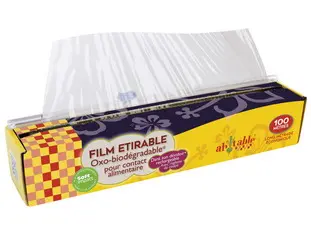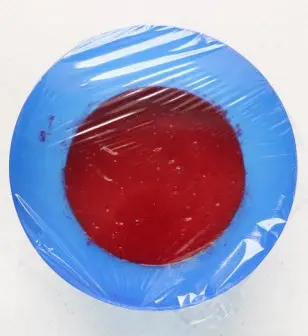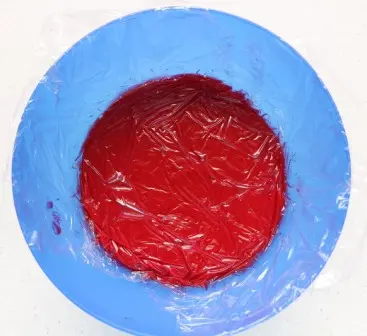This site uses only a few technical cookies necessary for its operation. By continuing to browse, you accept their use.
To find out more...
To find out more...
Using stretch food film effectively

Maybe you use food film in your own kitchen. You know, the very thin, clear plastic stuff that you can stretch, often used to cover food and protect it from the air.
It’s become so widely used that it’s now an essential item for pros. They even have a verb for it in French: “filmer”: to wrap or protect with this famous stretchy film.
It’s become so widely used that it’s now an essential item for pros. They even have a verb for it in French: “filmer”: to wrap or protect with this famous stretchy film.
Last modified on: May 12th 2018
Using stretch food film effectively
An indispensable aid in a professional kitchen, it’s also very useful for amateurs like us. If we need to put something in the fridge, such as leftovers, it’s very convenient to cover it with film first.
So let’s imagine that you have a portion of shepherd’s pie left (for example), still in its serving dish, and you want to keep it in the fridge for later in the week. You leave it to cool completely, just as you should, then cover with film and pop it in the fridge.
Naturally, you will cover the dish by stretching the film across the top, pull it down tight over the edges to seal it, then into the fridge it goes – quite normal.
But this method, though it does work after a fashion, is not very effective – and that’s what this post is all about. When we wrap or cover something with film, the idea is to seal it off from the air to reduce oxidation (of fresh produce) or stop it drying out (cooked food). If the film is simply stretched over the top of the container, some air (even if only a little) will be trapped inside with the food and the protection is not very efficient.
Here’s the trick: to protect food effectively with film, it is better to have the film in direct contact with the food. Stretching it doesn’t help; on the contrary. Pressing the loose film onto the food isolates it completely from the air.
Let’s look again at the shepherd’s pie example: you should lay the film over the top, of course, then make sure it follows the “cut” edge down, over the shape left by the serving spoon, to protect this exposed part.
Here is an illustration showing a strawberry coulis. This tends to oxidise rapidly if prepared in advance. The photo on the left show the “traditional” way to cover; the one on the right shows the film in direct contact with the coulis which, protected like this, will keep both its red colour and all its flavour.
To sum up: To protect food with plastic film, it is best to have the film in direct contact with the food.
So let’s imagine that you have a portion of shepherd’s pie left (for example), still in its serving dish, and you want to keep it in the fridge for later in the week. You leave it to cool completely, just as you should, then cover with film and pop it in the fridge.
Naturally, you will cover the dish by stretching the film across the top, pull it down tight over the edges to seal it, then into the fridge it goes – quite normal.
But this method, though it does work after a fashion, is not very effective – and that’s what this post is all about. When we wrap or cover something with film, the idea is to seal it off from the air to reduce oxidation (of fresh produce) or stop it drying out (cooked food). If the film is simply stretched over the top of the container, some air (even if only a little) will be trapped inside with the food and the protection is not very efficient.
Here’s the trick: to protect food effectively with film, it is better to have the film in direct contact with the food. Stretching it doesn’t help; on the contrary. Pressing the loose film onto the food isolates it completely from the air.
Let’s look again at the shepherd’s pie example: you should lay the film over the top, of course, then make sure it follows the “cut” edge down, over the shape left by the serving spoon, to protect this exposed part.
Here is an illustration showing a strawberry coulis. This tends to oxidise rapidly if prepared in advance. The photo on the left show the “traditional” way to cover; the one on the right shows the film in direct contact with the coulis which, protected like this, will keep both its red colour and all its flavour.


To sum up: To protect food with plastic film, it is best to have the film in direct contact with the food.
Lasts posts
Butter vs. grease
We often read in a recipe where a pastry is put into a mould that, just before pouring, the mould should be buttered or greased. But what's the difference between these 2 terms?December 1st 20259695
Getting out of the fridge early
Very often when you're cooking, you need to take food or preparations out of the fridge, to use them in the recipe in progress. There's nothing tricky about this: you just take them out of the fridge and use them, usually immediately, in the recipe. But is this really a good method?November 24th 20251,1035
Who's making the croissants?
When you look at a bakery from the outside, you naturally think that in the bakery, the bakers make the bread, and in the laboratory, the pastry chefs make the cakes. It's very often like that, with each of these professions having quite different ways of working, but sometimes there's also one...November 23th 2025995
Oven height
When we put a dish or cake in the oven, we naturally tend to put it on the middle shelf, and that's what we usually do. But in some cases, this position and height can be a little tricky, so let's find out why.October 8th 20252,7205
The importance of sieving
In recipes that use a fine powder (flour, powdered sugar, etc.), you'll often see the advice to sift before using it. To sift is to pass the powder in question through a sieve (a very fine strainer) before incorporating it into your recipe. It's often advice, but is it really useful?September 3rd 20257,5273
Other pages you may also like
Should a sausage be pricked before cooking?
If you are using sausages in a recipe, you may have already asked yourself the question: Should you prick it before cooking it, or not? You will certainly find as many opinions "you should prick" as "you should not". Let's try to untangle all this.September 29th 201848 K4.1
The return of the "Norman hole"
You maybe know the "trou normand", this old gastronomic custom typically French which consists in taking a (small) glass of calvados, generally between the last course and the dessert? It's something that seems a bit anachronistic nowadays, having a glass of an alcohol of more than 60° in the...December 18th 202115 K4.8
Steam for baking bread
What does steam have to do with bread-making? This is not only a bakers' secret, it is something you might not think of at all: if you make bread and bake it like a cake, you will end up with bread, but pale and with a thick, hard crust – a long way from the golden-brown crusty loaf you had in...June 16th 2021147 K4.5
How to sprinkle well?
When in a recipe you need to sprinkle something, that is to say to spread a fine layer of powder (flour, sugar, etc.) on something, powdered sugar on a pie for example, you will probably use a fine strainer or a sieve, this is the best way to proceed. But is that all?May 23th 202310 K4.7
The 3 kinds of meringue
Meringue – what could be simpler? Just beaten egg whites with sugar added. This makes a fairly stiff mixture which can then be cooked in a cool oven to create those lovely, light confections. But in the world of professional patisserie, meringue comes in three different kinds. Even if the...June 14th 201364 K4.5
Follow this page
If you are interested in this page, you can "follow" it, by entering your email address here. You will then receive a notification immediately each time the page is modified or a new comment is added. Please note that you will need to confirm this following.
Note: We'll never share your e-mail address with anyone else.
Alternatively: you can subscribe to the mailing list of cooling-ez.com , you will receive a e-mail for each new recipe published on the site.










The 1 comment already posted on this page